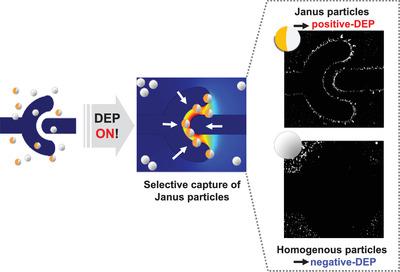当前位置:
X-MOL 学术
›
Biotechnol. J.
›
论文详情
Our official English website, www.x-mol.net, welcomes your
feedback! (Note: you will need to create a separate account there.)
Dielectrophoretic Manipulation of Janus Particle in Conductive Media for Biomedical Applications
Biotechnology Journal ( IF 3.2 ) Pub Date : 2020-10-16 , DOI: 10.1002/biot.202000343 Minji Lee 1 , Jong Bin Won 1 , Dae Ho Jung 1 , Jaekyoung Kim 1 , Yonghyun Choi 2 , Kubra Akyildiz 1 , Jonghoon Choi 2 , Kyobum Kim 3 , Jiung Cho 4 , Hyunsik Yoon 1 , Hyung‐Jun Koo 1
Biotechnology Journal ( IF 3.2 ) Pub Date : 2020-10-16 , DOI: 10.1002/biot.202000343 Minji Lee 1 , Jong Bin Won 1 , Dae Ho Jung 1 , Jaekyoung Kim 1 , Yonghyun Choi 2 , Kubra Akyildiz 1 , Jonghoon Choi 2 , Kyobum Kim 3 , Jiung Cho 4 , Hyunsik Yoon 1 , Hyung‐Jun Koo 1
Affiliation

|
Janus particles are applied to many fields including biomedical applications. To expand the usability of Janus particles, a technique to manipulate the particle movement is required. A dielectrophoresis (DEP) method can be a promising candidate; however, independent manipulation or separation of Janus particle by DEP is still challenging. Additionally, DEP of Janus particles in conductive media is important especially for biomedical applications where ion‐rich media are typically used. Here, the experimental results of DEP‐induced transport and separation of the Janus particle in conductive media are presented. To predict the DEP behavior, the Clausius–Mossotti (CM) factors of both Janus and homogeneous particles are calculated, depending on the alternating current (AC) frequency and medium conductivity. The Janus particles show the positive‐DEP behavior at the entire AC frequency region tested due to the metal‐coated half surface. On the other hand, the homogeneous particles show the negative‐DEP behavior at the high AC frequency or in conductive media. Additionally, in the conductive media, an electrohydrodynamic flow hinders the DEP‐driven particle transport below MHz AC frequencies. Finally, the separation of the Janus particles from the homogeneous ones is experimentally demonstrated and the separation efficiency is discussed based on the evaluation parameters established in this study.
中文翻译:

用于生物医学应用的导电介质中Janus粒子的介电泳操纵
Janus颗粒被应用于许多领域,包括生物医学应用。为了扩展Janus粒子的可用性,需要一种操纵粒子运动的技术。介电电泳(DEP)方法可能是一个有前途的候选方法。然而,通过DEP来独立操作或分离Janus颗粒仍然具有挑战性。此外,导电介质中Janus颗粒的DEP尤其重要,对于通常使用富离子介质的生物医学应用而言。此处介绍了DEP诱导的Janus颗粒在导电介质中的迁移和分离的实验结果。为了预测DEP行为,根据交流(AC)频率和中等电导率,计算了Janus和均质粒子的Clausius-Mossotti(CM)因子。由于金属涂层的一半表面,Janus颗粒在测试的整个AC频率区域显示出正DEP行为。另一方面,均质颗粒在高交流频率或导电介质中表现出负DEP行为。此外,在导电介质中,电动流体流动会阻碍DEP驱动的颗粒在MHz交流频率以下的传输。最后,通过实验证明了Janus颗粒与均质颗粒的分离,并基于本研究建立的评估参数讨论了分离效率。电动流体流动阻碍了DEP驱动的颗粒在低于AC频率的交流。最后,通过实验证明了Janus颗粒与均质颗粒的分离,并基于本研究建立的评估参数讨论了分离效率。电动流体流动阻碍了DEP驱动的颗粒在低于AC频率的交流。最后,通过实验证明了Janus颗粒与均质颗粒的分离,并基于本研究建立的评估参数讨论了分离效率。
更新日期:2020-12-07
中文翻译:

用于生物医学应用的导电介质中Janus粒子的介电泳操纵
Janus颗粒被应用于许多领域,包括生物医学应用。为了扩展Janus粒子的可用性,需要一种操纵粒子运动的技术。介电电泳(DEP)方法可能是一个有前途的候选方法。然而,通过DEP来独立操作或分离Janus颗粒仍然具有挑战性。此外,导电介质中Janus颗粒的DEP尤其重要,对于通常使用富离子介质的生物医学应用而言。此处介绍了DEP诱导的Janus颗粒在导电介质中的迁移和分离的实验结果。为了预测DEP行为,根据交流(AC)频率和中等电导率,计算了Janus和均质粒子的Clausius-Mossotti(CM)因子。由于金属涂层的一半表面,Janus颗粒在测试的整个AC频率区域显示出正DEP行为。另一方面,均质颗粒在高交流频率或导电介质中表现出负DEP行为。此外,在导电介质中,电动流体流动会阻碍DEP驱动的颗粒在MHz交流频率以下的传输。最后,通过实验证明了Janus颗粒与均质颗粒的分离,并基于本研究建立的评估参数讨论了分离效率。电动流体流动阻碍了DEP驱动的颗粒在低于AC频率的交流。最后,通过实验证明了Janus颗粒与均质颗粒的分离,并基于本研究建立的评估参数讨论了分离效率。电动流体流动阻碍了DEP驱动的颗粒在低于AC频率的交流。最后,通过实验证明了Janus颗粒与均质颗粒的分离,并基于本研究建立的评估参数讨论了分离效率。











































 京公网安备 11010802027423号
京公网安备 11010802027423号